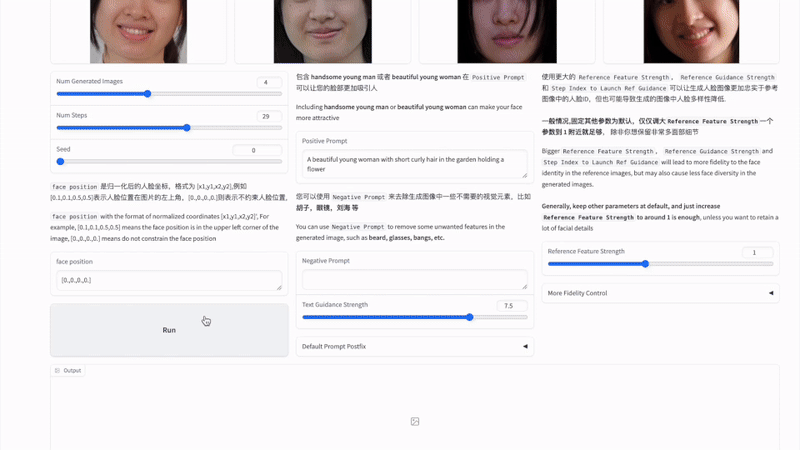FlashFace
by Alibaba and HKUFlashFace is a high-fidelity AI portrait tool developed by Alibaba and HKU, generating personalized portraits based on facial images and text prompts.
FlashFace: High-Fidelity AI Portrait Tool by Alibaba and HKU
What is FlashFace?
FlashFace is a high-fidelity AI portrait tool developed by Alibaba and HKU. It generates personalized high-fidelity portrait images based on user-provided facial images and text prompts. FlashFace features high-fidelity identity retention, instant personalization, and diverse result generation. It supports changing a person's age and gender, and even transforming virtual characters into realistic human photos. FlashFace can also convert real photos into different artistic styles or blend multiple character traits to create new images. It is suitable for personalized photo creation, virtual character design, and movie and game character design.
Key Features of FlashFace
- High-Fidelity Identity Retention: Accurately captures and retains the features of the reference face, including details such as tattoos and scars.
- Instant Personalization: Users only need to provide a reference image and text prompt to quickly generate personalized photos.
- Diverse Results: Generates multiple personalized portrait results while retaining the identity features of the reference face.
- Age and Gender Change: Adjusts the age and gender of a person with a single click, providing different visual experiences.
- Virtual Character to Real Person: Transforms fictional characters into realistic human photos.
- Real Person to Artwork: Converts real photos into different artistic styles.
Technical Principles of FlashFace
- Deep Learning: Uses deep neural networks to learn and simulate facial features and structures, including facial expressions, contours, and textures.
- Generative Adversarial Networks (GANs): Trains two networks—Generator and Discriminator—to generate realistic facial images. The Generator creates images, while the Discriminator evaluates their authenticity.
- Facial Feature Extraction: Uses deep learning models to extract key facial features from the provided reference images, such as the position and shape of eyes, nose, and mouth.
- Conditional Generation: Guides the Generator to produce faces with specific attributes, such as age, gender, or particular expressions, through text prompts or additional conditional inputs.
- Identity Retention: Specially designed networks maintain the unique identity features of the input image during the generation process, ensuring the generated portrait visually resembles the reference image.
- Style Transfer: Applies an artistic style or texture to the generated facial image, converting real photos into artworks.
- Multimodal Learning: Combines visual and text data, enabling the model to understand and respond to text descriptions, generating portraits that match the descriptions.
- Optimization and Regularization Techniques: Uses various optimization algorithms and regularization techniques to improve the quality and diversity of generated images while avoiding common issues like mode collapse.
Project Links
- Official Website: https://jshilong.github.io/flashface-page/
- GitHub Repository: https://github.com/ali-vilab/FlashFace
- arXiv Technical Paper: https://arxiv.org/abs/2403.17008
Application Scenarios of FlashFace
- Personalized Photo Creation: Users can create personalized photos for themselves or loved ones, which can be used as birthday gifts, holiday souvenirs, or other special occasion mementos.
- Virtual Character Design: Designers and content creators can use FlashFace to generate realistic virtual characters for social media, blogs, or any scenario requiring personalized virtual characters.
- Movie and Game Production: In movie effects and game character design, FlashFace can create highly realistic facial features, enhancing visual effects and character realism.
- Advertising and Marketing: Advertisers can use FlashFace to generate attractive images for promotional campaigns, capturing the attention of potential customers.
- Artistic Creation: Artists can use FlashFace to convert real photos into various artistic styles, exploring new forms of artistic expression.
Features & Capabilities
What You Can Do
Image Generation
Personalized Photo Creation
Virtual Character Design
Movie And Game Character Design
Artistic Style Transfer
Categories
AI Portrait
High-Fidelity
Personalization
Virtual Character
Image Generation
Deep Learning
GANs
Facial Feature Extraction
Style Transfer
Multimodal Learning
Example Uses
- Personalized Photo Creation
- Virtual Character Design
- Movie and Game Character Design
- Artistic Style Transfer
Getting Started
Pricing
free
Screenshots & Images
Primary Screenshot

Additional Images




Stats
241
Views
0
Favorites

